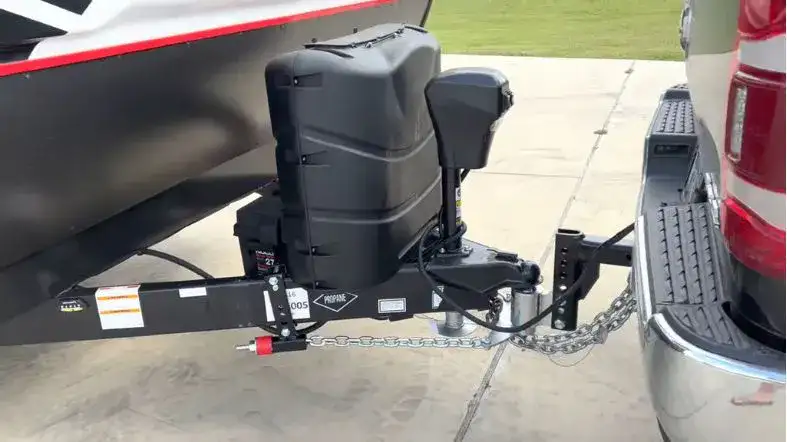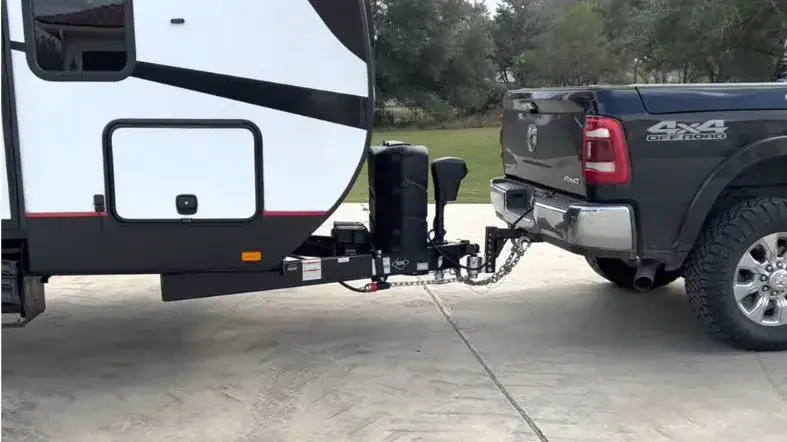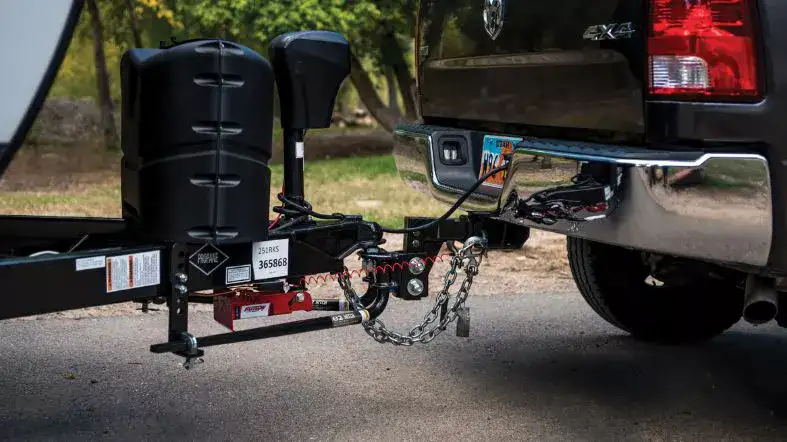Are you tired of your trailer swaying and causing your tow vehicle to feel unstable on the road?
A weight distribution hitch can help distribute the load more evenly, improving stability and handling.
But how much weight can these hitches actually distribute?
In this blog, we’ll explore the capabilities of weight distribution hitches and how they can help improve your towing experience.
How much weight does a weight distribution hitch distribute?
The amount of weight transferred can vary, with most weight distribution hitches having a maximum capacity between 10,000 and 14,000 pounds, and transferring up to two-thirds of the trailer’s Gross Trailer Weight Rating (GTWR).

How does a weight distribution hitch work?
A weight distribution hitch balances the trailer’s load using springs and chains between the vehicle and trailer axles.
This helps to prevent trailer sway and level out the vehicle and trailer so that they sit evenly.
There are two main types of weight distribution hitches: those with chains or bars and those with springs.
Chain and bar type
Chain and bar weight distribution hitches use chains or bars to distribute the weight evenly between the vehicle and trailer axles.
These hitches are typically adjustable so that you can customize the amount of weight distribution.
Spring-type
Springs are the other primary type of weight distribution hitch.
These hitches use springs to distribute the weight evenly between the vehicle and trailer axles.
Springs are not as adjustable as chains or bars but provide a smoother ride.
It is essential to correctly adjust your weight distribution hitch for your specific vehicle and trailer combination, no matter what type you use.
What Are The Benefits Of Using A Weight Distribution Hitch?

A weight distribution hitch can improve your trailer by evenly distributing the weight.
Reduce wear and tear
This can help to keep the trailer from fishtailing or becoming unstable and can also help reduce wear and tear on your vehicle.
Increase the level of rig
Another benefit of using a weight distribution hitch is that it can help to level your rig.
This can improve towing stability and braking and can also help to reduce strain on your vehicle.
Money saving
Investing in a weight distribution hitch is a good idea if you frequently tow a trailer or plan on doing any long-distance towing.
It can help keep your rig stable and safe and save you money in the long run by preventing damage to your vehicle.
How Do I Choose The Correct Weight Distribution Hitch For My Vehicle?

When choosing a weight distribution hitch for your automobile, there are a few factors to consider.
Weight
You must first be aware of your trailer’s weight.
With this information, pick a hitch that is correctly rated for the weight of your trailer.
Knowing the weight of your car is also essential since it will determine how much weight the hitch can support.
Size
This is important because the hitch needs to be able to distribute the weight of the trailer evenly.
If the hitch is too slight, it will not be able to distribute the weight properly and could cause problems on the road.
A weight distribution hitch too large or too small for your vehicle can be challenging to install and may need to be fixed.
Installation
Another thing to consider is how easy the installation process is.
Some hitches can be challenging to install, and you may need a professional to do it for you.
Suppose you are not comfortable installing the hitch yourself.
In that case, it is essential to choose one that comes with easy-to-follow instructions.
This will simplify the process considerably and help guarantee proper hitch installation.
Type
There are two main types of weight distribution hitches: sliding and stationary.
Sliding hitch
A sliding hitch can move side-to-side, which can be helpful when making turns.
This type of hitch is typically easier to install than a stationary hitch.
Stationary hitch
A stationary hitch is mounted in a fixed position.
This hitch is more challenging to install but can provide a more secure connection between the trailer and the vehicle.
Cost
Finally, consider cost when choosing a weight distribution hitch.
These hitches range in price, so you will need to decide how much you are willing to spend.
Also, a more expensive hitch is not necessarily better than a less expensive one.
You will need to compare the features of each hitch to find the one that best meets your needs.
How Do I Install A Weight Distribution Hitch?
If you are uncomfortable installing the hitch, a professional can always do it.
But installing a weight distribution hitch is a simple process, it is essential to follow the instructions carefully. Just it.
Step 1
The first step is determining where the hitch will be mounted on your vehicle.
The best location is usually just behind the rear axle.
Step 2
Once you have determined the location, you will need to measure the distance between the hitch and the axle.
This measurement will determine the length of the chains or straps you need to connect the hitch to the axle.
Step 3
Next, you will need to attach the brackets that came with your hitch to your vehicle’s frame.
These brackets will help to support the hitch and keep it in place.
Step 4
Once the brackets are in place, you can then attach the hitch to the brackets.
Ensure the hitch is securely attached before moving on to the next step.
Step 5
You will need to attach the chains or straps to the hitch.
The chains or straps will connect the hitch to the axle.
Make sure the chains or straps are securely attached before moving on to the next step.
Step 6
Finally, you must adjust the tension on the chains or straps.
This will help to distribute the weight evenly and prevent the hitch from wobbling.
Step 7
Once the tension is adjusted, you can test the hitch by backing up and making turns. If everything is working correctly, you can hit the road.
Weight distribution hitches are a great way to distribute your trailer’s weight evenly.
This will help to prevent problems on the road and will make towing your trailer a much smoother process.
How do I properly use a weight distribution hitch?
To properly use a weight distribution hitch, you will need to make sure that the hitch is installed correctly.
You will also need to adjust the tension on the chains or straps to distribute the weight evenly.
Finally, you should test the hitch by backing up and making turns.
FAQs about the weight that a weight distribution hitch distributes
What Is A Weight Distribution Hitch?
A weight distribution hitch is a device used to evenly distribute a trailer evenly.
This will help to prevent problems on the road and will make towing your trailer a much smoother process.
How Important Is It To Choose A Hitch That Comes With Easy-To-Follow Instructions?
It is very important to choose a hitch that comes with easy-to-follow instructions.
This will simplify the process considerably and assist in guaranteeing proper hitch installation.
How Can I Determine Whether My Trailer Needs A Weight Distribution Hitch?
Consulting a professional is the best method to determine if a weight distribution hitch is appropriate for your trailer.
They can help you decide which hitch is the best option.
How Often Should I Check My Weight Distribution Hitch?
You should check your weight distribution hitch before each trip to ensure that it is properly installed and adjusted.
You should also check it periodically during your trip to ensure it is still working correctly.
What Are Some Common Problems With Weight Distribution Hitches?
Some common problems with weight distribution hitches include loose chains or straps, incorrect tension, and poor installation.
The bottom lines
The weight of your trailer is equally distributed between the tow vehicle and the trailer using a weight distribution hitch, making towing more accessible and safer.
When buying a weight distribution hitch, it’s impotent to consider the tongue weight rating of your tow vehicle and trailer.
It’s alsIt’sportant to choose the right size hitch for your application.
This article has helped you understand how a weight distribution hitch works and how to select the right one for your needs.
